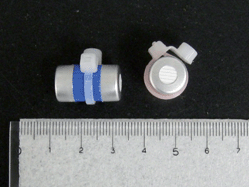Exposure to various chemicals can cause adverse effects to health, such as asthma and allergies, especially in children. Data on personal exposure levels in children are scarce, thus small lightweight diffusive mini-samplers for aldehydes and volatile organic compounds (VOCs) were designed to measure the exposure level of children to these chemicals. The aim of the study was to validate and examine the applicability of these mini-samplers for measuring daily chemical exposure. The diffusive mini-samplers are 20 mm in length, 11 mm in diameter, and 1.67 g in weight. The devices are cylindrically shaped with polytetrafluoroethylene membrane filters placed at each end. To measure aldehydes and acetone, 20 mg of 2,4-dinitrophenylhydrazine was used as an absorbent. To measure VOCs, a carbon molecular sieve was used. The sampling rate for each chemical was determined by parallel sampling with active samplers in a closed exposure bag. The blank levels of the chemicals and the storage stability of the device were tested. The mini-samplers were compared to commercially available diffusive samplers. To examine the applicability of the samplers, 65 elementary school children carried them for 24 h. The sampling rates for formaldehyde, acetaldehyde, and acetone were 20.9, 22.9, and 19.7 mL min−1, respectively. The limits of quantification (LOQ) for the 24-hour sampling by high-performance liquid chromatography/ultraviolet (HPLC/UV) analysis were 8.3, 7.6, and 8.8 μg m−3 for formaldehyde, acetaldehyde, and acetone, respectively. The sampling rates for the 11 VOCs were determined and ranged from 3.3 mL min−1 for styrene and 2-ethyl-1-hexanol to 11.7 mL min−1 for benzene. The LOQ for the 24-hour sampling by gas chromatography-mass spectrometry (GC-MS) analysis ranged from 5.9–105.2 μg m−3, 1.1–24.7 parts per billion. The storage stability after 5 days ranged from 94.8 to 118.2%. Formaldehyde, acetone, benzene, and toluene were detected above the LOQ in more than 90% of the children, and the median concentrations were 21.7, 20.9, 10.1, and 21.5 μg m−3, respectively. This study shows that the diffusive samplers developed were suitable for children to carry and were capable of measuring the children's daily chemical exposure.


 Please wait while we load your content...
Please wait while we load your content...